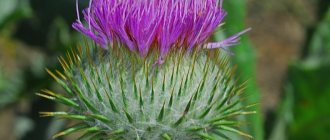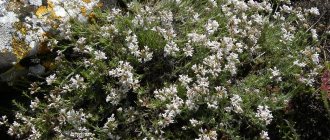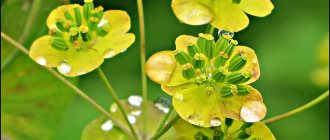Sophora japonica (another name is Japanese styphnolobia) is a deciduous tree up to 25 m high from the Legume family. It grows in the Far Eastern countries: China, Korea, Japan, and has spread throughout the globe. It is one of the symbols of the capital of China: in the monastery called Sanshenan there is an ancient tree, which is more than 400 years old. A distinctive feature that identifies the species from other trees is its fragrant white-yellow flowers, which bloom only once every 2 years.
The plant is unpretentious to the soil, prefers loam, but can also grow in conditions of high salinity. Prefers rocky hills, saline meadows, valleys, lake and river banks. Tolerant to arid climates and does not require constant lighting. However, it does not tolerate prolonged exposure to cold temperatures and winds.
A little history
The medicinal properties of Sophora japonica have been known since ancient times, although the first use of the plant's flowers was as a dye. Then the tree was called “crying” and was planted next to temples. It was believed that the tree not only helps in treating ailments, but also can read a person’s thoughts and help make the right decision.
Eastern peoples worshiped the “weeping tree.” The Chinese were confident that fragrant flowers could prevent strokes, and were among the first to use preparations based on parts of the plant as an anti-inflammatory and analgesic.
In 1747, Far Eastern botanist breeders began cultural breeding of the plant, mainly as an ornamental one. Already at the beginning of the 19th century, styphnolobia was brought to the Nikitsky Botanical Garden, located near Yalta, where the tree took root well and subsequently spread throughout the entire Crimean peninsula, as well as throughout Ukraine (Kherson and Odessa regions). The plant has taken root well in the Krasnodar Territory, the Amur Region, Primorye, Sakhalin, Transcaucasia, Altai and the Caucasus.
It is an excellent honey plant and decorates botanical gardens and cultural plantings in parks and squares. Sophora japonica preparations have found application in medicine and are effective for various, including the most serious, diseases.
Where does Sophora japonica grow?
Fruits in a year. Blooms at the end of summer. Large inflorescences of white or pinkish flowers in the form of panicles delight the eye and sense of smell. Active honey plant. Sophora is thermophilic, drought-resistant, shade-tolerant.
Does not tolerate severe frosts and cold winds. Grown in Crimea, Transcaucasia.
The fruits are indehiscent beans of a reddish color. They ripen by November and remain on the tree until spring.
The medicinal properties of Sophora japonica have been used since ancient times in the medicine of various peoples.
Most used: flowers and fruits. They are collected in an unripe form: flowers at the budding stage, fruits before the bean leaves dry. The buds are collected dry when there are no traces of dew or rain.
The beans are harvested in October, until fully ripe. The panicles are cut off with pruning shears or carefully broken off. The buds contain a large amount of flavonoids, and the fruits contain alkaloids.
Photo of Japanese Sophora
Morphological description
The tree can reach a height of up to 25 meters (in the middle zone - 10-15 meters), has a wide spherical spreading crown. The top of the trunk is covered with bark, which over time becomes dark gray and becomes covered with cracks. Young branches are thornless and green.
The leaves are odd-pinnate, 11-25 cm long. The leaves, of which there are from 19 to 17 pieces per branch, are oblong-ovate, 2-5 cm long. They fall off in the winter.
It blooms for the first time 30 years after the start of growth. The flowers are yellowish-white in color, collected in loose panicles that reach a length of up to 35 cm. They emit a very pleasant aroma. The tree blooms once every 2 years, flowering occurs in July-August.
The fruit is a juicy, indehiscent cylindrical bean with distinct thickenings. At first the beans are greenish-brown, and when ripe they become reddish, 3-8 cm long. They ripen in September-October, do not fall off and stay on the tree all winter.
Externally, Sophora is similar to acacia, and they are sometimes even confused. However, the plant's characteristic fruits make it easy to identify.
From a Chinese collection of recipes
- Japanese Sophora for bleeding Drink a decoction of a tablespoon of Sophora buds in ½ liter of water in equal portions throughout the day.
- Rinse mouth and throat Grind fresh shoots and leaves (2 tablespoons), leave in 0.5 liters of boiling water. Rinse your mouth and throat after 2-3 hours.
- Eczema, skin diseases Ointment. 1 part Sophora root powder to 2 parts Vaseline.
- Dysentery, diarrhea 2 g of root powder four times a day.
- Relieving swelling, stimulating appetite 3 grams of root powder three times a day.
- Frequent nosebleeds Infusion of equal parts of buds and fruits, one tablespoon 3 times a day. Soak the turundas with the infusion and put it in the nose.
- Strengthening hair Apply infusion or tincture of buds internally. Rinse your hair with infusion of flowers (2 teaspoons per liter of water). Wipe the scalp with tincture of flowers.
- Normalization of blood clotting 40 drops of alcoholic tincture of flowers after each meal.
Sophora japonica is truly a healer for a hundred diseases.
The main thing is to correctly use its medicinal properties, take into account contraindications, and follow the rules for taking and preparing medications.
Beneficial properties of Styphnolobia japonica
The pharmaceutical activity of the plant is very high, which makes it possible to use it in various fields of medicine.
- Reduces capillary fragility, promotes the dissolution of atherosclerotic plaques and intravascular blood clots, and heals blood vessels thanks to the content of rutin. This flavonoid exhibits P-vitamin activity and helps reduce blood viscosity. These positive effects can reduce the load on a person’s heart and thereby prevent dangerous heart diseases.
- Neutralizes free radicals and exhibits antioxidant properties; in some cases, it acts as an antidote for poisoning, which allows the plant to be used in patients with cancer at the stage of preparation for undergoing courses of chemotherapy and radiotherapy. These effects are associated with the action of kaempferol and quercetin.
- Relaxes the walls of blood vessels and helps normalize blood pressure due to the content of alkaloids.
- Activates regeneration and stimulates reparative processes in tissues. Restores cells, accelerates wound healing, regulates metabolic processes, and is a natural biostimulant.
- Reduces the severity of allergic reactions and their manifestations, such as itching, skin rash.
- Gently stimulates the function of the adrenal cortex, regulates urination and eliminates swelling.
- Improves the body's protective properties, especially in patients with chronic diseases of the respiratory system and gastrointestinal tract (acute and chronic hepatitis). It has been proven that the use of the plant in the complex treatment of tuberculosis increases the effectiveness of therapy by 30-50%.
- Has a detrimental effect on microbes and viruses. Helps thin and remove mucus, eliminates inflammation.
Plant preparations have found clinical use in the treatment of cancer, heart disease, viral hepatitis, gastric and duodenal ulcers, thyrotoxicosis and toxic goiter, vascular diseases (hemorrhoids, atherosclerosis and varicose veins), hypovitaminosis. Traditional healers recommend the plant for external and internal bleeding (including hemorrhage in the brain and retina), hematoma, bronchial asthma, tuberculosis, sinusitis, diabetes, colitis, pancreatitis, poisoning, abscesses, periodontal disease, sepsis, hemorrhagic diathesis, anemia and impotence. Externally and locally used in the form of irrigation, compresses, washing, rinsing, wet dressings, rinsing for hair loss, aging skin, erosion (including the cervix), abscess, phlegmon, trophic ulcers, burns, frostbite and wounds with the formation of pus and necrosis, cystic and fibrous neoplasms.
Thus, the plant has a hypotensive, anti-edematous, capillary-strengthening, antispasmodic, vasodilator, antitumor, antioxidant, antiallergic, anti-inflammatory, antiviral, antimicrobial, immunomodulatory, regenerating, hemostatic effect and, when used correctly, in dosage, helps in the treatment and prevention of various diseases. However, you should not expect an immediate effect: improvement is observed only after a course of therapy.
Mistletoe and Sophora Japanese tincture.
Mistletoe is a well-known tree parasite that has a spherical shape. I’ll say right away that, contrary to various beliefs, it doesn’t matter what tree you picked mistletoe from, its medicinal properties do not change. It makes no sense to look for mistletoe only from an apple tree, or, say, from a spruce tree; it is much more important to take care of the place where it grows. Mistletoe from roadside trees is no good, it will only harm yourself and not help you. Look for environmentally friendly places, go deep into the forest, there you will definitely find such a useful ball for you.
Mistletoe has long been known as a sedative, cardiotonic, antitumor, and immunomodulatory agent.
In combination with sophora beans, mistletoe becomes an excellent and effective tincture for the following diseases:
- haemorrhoids
- varicose veins
- myoma
- mastopathy
- hypertension
- thrombophlebitis
- psoriasis
- lupus erythematosus
- heart attack
- stroke
- tumor diseases
- immunodeficiency
- atherosclerosis
- heart attack
- cardiac ischemia
- diabetes
- vegetative-vascular dystonia
Tincture of sophora and mistletoe is taken a teaspoon 3-4 times a day half an hour before meals.
Making it won't be difficult either. You will need 25 grams of sophora fruits and mistletoe leaves per bottle of high-quality vodka. Leave for a month or as long as necessary until the tincture becomes a rich dark brown color. Then it can and should be applied.
Collection and preparation
Of medicinal value are the unopened buds and unripe fruits of Sophora japonica, which are collected from trees growing in parks and squares outside the city limits. The two types of raw materials are collected in dry, clear weather, but at different times of the year.
- At the beginning of summer, at the end of budding, the buds are collected, at the moment when the flowers bloom on the lowest inflorescences. Only the buds are removed from the cut inflorescences, which are dried in partial shade for about 2 hours and then dried using classical technology, in a dry, ventilated place, protected from moisture and direct sunlight. Can also be dried in dryers at 40 - 45 °C.
- The fruits are harvested unripe when they are still green. In the middle zone, it is the fruits that do not ripen to biological ripeness. Therefore, the harvesting period will fall in the fall until the end of the season (September-October), but it is very important to collect the fruits before night frosts occur. Frostbitten fruits lose their healing properties. Dry the raw materials in an oven or dryer at 25 - 30 °C.
Store in linen bags for 1 year.
Herbalists advise harvesting seeds (to expel parasites from the body), leaves (from which an infusion is prepared for rinsing the mouth) and roots (used to prepare a decoction). In the Far Eastern countries, valuable essential oil is obtained from seeds that activate the body’s defenses, which can rarely be found on sale.
Japanese Sophora for hair loss: recipe for use
This is what the fruits of Sophora japonica look like.
If your hair is falling out, decoctions and infusions from Sophora will help to strengthen it and improve growth . And if rinsing and washing your hair with Sophora is combined with a head massage , the effect will be even greater.
Fruit decoction
- Take 20 g of Sophora fruits and fill them with 1 glass of boiled water.
- Cook at low boil for 15 minutes.
- Strain the broth, cool and rub into the head and hair roots.
Infusion of fruits
- Pour 20 g of Sophora fruits into 1 glass of boiled water.
- Leave for 15 minutes and strain.
- When it cools down, rub it into your hair, preferably into the roots.
You can also use alcohol tincture for hair loss. It is diluted with water 1:10, or 1:5, and rubbed into the roots.
Pharmaceutical and cosmetic preparations of Sophora japonica
AskorutinA drug prescribed for the prevention and treatment of capillary fragility, especially if their damage is associated with treatment with anticoagulants or salicylates, the prevention and treatment of hypo- and avitaminosis P and C, the treatment of pathologies in which increased vascular permeability develops. Price: tablets No. 50: 30-60 rub. |
Sophora + vitamins for blood vesselsA dietary supplement recommended as an additional source of flavonoids, vitamins, manganese, magnesium, copper, zinc, chromium and selenium. Prescribed to patients to prevent stroke and heart attack, as well as during the rehabilitation period after them. Price: No. 50: 180-280 rub. |
Face cream with Sophora japonica from Natura SibericaRutin has a protective effect against free radicals, promotes rapid cell renewal and cleansing of the skin, narrowing enlarged pores, and improving turgor. Recommended for mature skin, as well as in the presence of spider veins, acne, and pustular elements. Price: 380 rub. |
Dry fruits and herbal teas
|
PahikarpinIt is used to relieve spasms of peripheral vessels, muscle dystrophy, obliterating endarteritis, inflammation of nerve ganglia, to stimulate labor and stop bleeding in the postpartum period. Can only be purchased in Ukraine. Approximate price: 800 rub. |
Sophora japonica in traditional medicine
Rutin is used as part of systemic enzyme therapy preparations. The role of rutin is to complement the therapeutic effect of enzymes.
Askorutin
Ascorutin: ascorbic acid and rutin.
The antioxidant ability of rutin inhibits the oxidation of ascorbic acid. It is used when the integrity and functionality of blood vessels is impaired - from large to capillaries.
And such phenomena are observed in diabetes (rhinopathy), hemorrhages, scarlet fever, measles, influenza (capillary toxicosis), radiation sickness, hemorrhoids.
Troxerutin is a derivative of rutin. Gel for external use for varicose veins, peripheral venous insufficiency, leg ulcers, periphlebitis, edema and hematomas after injuries and operations, consequences of radiation therapy.
Recipes with Sophora japonica
Dosage forms with the plant are used for both internal and external treatment. It is very important to follow the cooking technology. Unless otherwise indicated, internal treatment is carried out for 1 month, with a break between courses of 10-30 days. For preventive purposes, the drugs are taken 4 times a year, 1 month per course.
Alcohol tincture of Sophora japonica
- Traditional healers consider this form to be the most effective: alcohol enhances the effectiveness of the plant. Recommended for the treatment of internal bleeding, retinal damage, hypertension, angina pectoris, colitis, chronic pleurisy, diabetes mellitus and other pathologies. Externally used to strengthen hair, treat ulcers, wounds, burns, and for rinsing - for stomatitis, periodontal disease.
- Preparation: fresh fruits are poured with 56% alcohol in a 1:1 ratio. If there are dry beans, prepare an infusion in a 1:2 ratio. Leave for 3 weeks, then filter and squeeze the fruits thoroughly.
- Take 5 times a day, in a single dose of 10 drops to 1 tsp. Treatment is carried out for 2 weeks. For external use, dilute with water: 1 tbsp. l. per 100 ml of water. To rinse your mouth, take 1 tbsp for 1 glass. l. tinctures.
Decoction
- Traditionally it is prepared from the root of a tree, but you can also use the fruit. The decoction has proven itself in the treatment of colds and sore throats. Externally used to strengthen hair follicles: helps against hair loss.
- Preparation: 1 tbsp. l. crushed fruits are poured with a cup of boiling water (150 ml) and simmered for 10 minutes over low heat. Then the volume of the product is increased to the same level with boiling water, cooled and filtered.
- Take 25 ml three times a day. Externally: rinse hair after washing 3 times a week.
Root decoction
- Used as an antipyretic in the treatment of tuberculosis, malaria, and jaundice.
- Preparation: 1 tbsp. roots, pour 250 ml of boiling water and cook in a water bath for 10-12 minutes. After the preparation has cooled, filter and top up with boiled water to the previous volume.
- Take 25 ml 3 times a day.
Infusion
- Used in the treatment of ulcers, wounds, eczema and other skin lesions.
- Preparation: take 15 g. dried fruits, add 300 ml of hot water, infuse for 60 minutes, filter and bring the volume of the preparation with boiled water to the original 300 ml.
- Used for dressings, irrigation, washing, wet dressings.
Tea
- Positioned as a general tonic that prolongs youth and maintains good health. Normalizes blood pressure, has an anti-inflammatory effect, helps get rid of the symptoms of approaching menopause.
- Preparation: take fruits and flowers in equal proportions and mix, 2 tbsp. pour 500 ml of boiling water over the mixture and boil for 5 minutes, leave for another hour, filter. You can add 1 tsp to the mixture. dry rose hips.
- Take 150 ml three times a day. Used externally to strengthen hair roots (rub into scalp before bed).
Oil
- Used to treat wounds, rhinitis (as oil drops in the nose). Used to treat psoriasis, healing burns, insect bites, allergic rashes.
- Preparation: the fruits are poured with boiling water in a 1:1 ratio. After 60 min. The steamed fruits are ground to a paste, poured with vegetable oil in a ratio of 1:3 and left in the open sun for 3 weeks.
- Place 1 drop in each nostril 3 times a day for acute rhinitis. Apply externally to skin lesions several times a day. People who used Sophora japonica for psoriasis were able to get rid of psoriatic rashes within 1-1.5 months.
Powder
- Recommended for conditions similar to the use of decoction and tincture of the plant. To obtain it, dried flowers are ground using a coffee grinder.
- Take 0.5 g. 3 times a day.
Lotion
Recommended for skin rejuvenation.
- Preparation: 200 gr. The flowers of the plant are poured with 500 ml of vodka, left for 2 weeks and then not filtered.
- Wipe the skin of the face 2 times a week, no more often. For this, 1 tbsp. The lotion is diluted with water in a ratio of 1:10, the preparation is applied to a cotton pad and the skin of the face and neck is carefully treated along the massage lines.
Sophora honey
A beekeeping product that has a characteristic light amber color, pleasant aroma and taste. Honey is rich in minerals, vitamins, amino acids, proteins, it helps well in the treatment of inflammatory processes in the respiratory and gastrointestinal tract, and is also an excellent means of preventing various diseases.
Tincture for diabetes and oncology
- If these pathologies are present, traditional healers recommend a special recipe for preparing a tincture, which allows you to obtain an effective, concentrated drug.
- Preparation: 150 gr. fresh beans are ground to a powder, add 700 ml of vodka. Place in a dark place for 7 days, filter.
- Take 1 tsp. morning and evening, 1-3 months. contract.
Sophora japonica and mistletoe
The latter is a parasitic plant. Mistletoe is rich in choline, alkaloids, tannins, resins, saponin-containing and bitter substances, ceryl alcohol and fatty acids.
Together, Sophora japonica and mistletoe form a most valuable tandem that can deal a blow to many diseases. The active substances of the plants help strengthen and cleanse blood vessels, dissolve cholesterol plaques, calm the central nervous system, stop bleeding, normalize the functioning of the cardiovascular system, cleanse the blood of cholesterol and activate the body's defenses.
The most effective drug is a tincture, which is used to fight cancer, hypertension and atherosclerosis. Recommended for gastrointestinal, kidney and liver pathologies, prostatitis, sinusitis, mastopathy, hemorrhoids, fungal skin lesions, gynecological diseases, thrombophlebitis, varicose veins, diabetes, periodontal disease. Helps in the recovery period after a stroke and the use of chemical medications.
- Preparation: take 1 glass of mistletoe and sophora. Pour the plant mixture with 1 liter of alcohol and leave for 3 weeks.
- Take 3-4 times a day 40 minutes before meals, diluting 1 tsp. tinctures in 50-100 ml of water for at least 3 months in a row. The course is always determined individually. For example, in order to completely clear the blood vessels of atherosclerotic plaques, it is necessary to undergo treatment for at least six months. Repeated courses are carried out after a break of 1-2 months.
Medicinal properties of Japanese Sophora
Sophora japonica has beneficial properties and contraindications. There are more of the first. At home, the plant treats some gynecological ailments, cardiovascular pathologies, helps with diabetes and gastrointestinal diseases.
Sophora therapy:
- Gynecology. In this area, the antitumor and anti-inflammatory properties of the plant are assessed. It can be prescribed for vaginitis, cervicitis, colpitis, candidiasis, erosive lesions of the cervix, salpingitis and even fibroids. Sophora is considered valuable for women's reproductive health. Can be used orally, can be used in the form of douches. Traditional medicine recommends taking Sophora during menopause.
- Diseases of the heart and blood vessels. Since rutin is not produced in the body itself, its reserves must be replenished. The plant helps remove “bad” cholesterol from the body and prevents the formation of blood clots. Rutin strengthens blood vessels, has a beneficial effect on blood circulation in general, and reduces capillary permeability. Rutin is considered a preventive product against stroke, internal bleeding, etc.
- Diabetes. The herb organically affects the thyroid gland, the pancreas, and normalizes hormonal levels. The hypoglycemic properties of the plant have also been proven. Diabetics should use Sophora only under medical supervision. Typically, the herb is included in complex therapy.
- Digestive pathologies. It heals the mucous membrane well, which is why Sophora is drunk for stomach ulcers, as well as gastritis with high acidity. The plant is also used to help with colitis, hemorrhoids, and dysentery. It is often noted that with a stomach ulcer, pain can intensify. Some associate this with tissue regeneration, others with a signal that such treatment was not suitable for the patient.
- Oncology. The antitumor properties of Sophora are noted by herbalists. The plant today is primarily used as a supportive herbal therapy.
- Detox. The plant is rich in natural antioxidants, which removes toxins from the body and cleanses the blood and liver.
- Outdoor use. The use of alcohol tincture of Sophora japonica is also possible in the form of irrigations, mouth rinses, compresses and lotions. They can be used for rheumatism (lotions and compresses), decoctions are used to lubricate the skin for psoriasis, dermatitis, allergies, cracks and burns, purulent processes.
Of course, the healing properties of the plant will be revealed with proper use, based on indications, absence of contraindications, dosage and treatment regimen.
This video is also devoted to the medicinal properties of Japanese Sophora.
Side effects
Allergic phenomena, diarrhea, nausea, vomiting are possible in some patients, which appear some time after the start of treatment, i.e. not right away. If the recommended doses are exceeded, blood pressure may rise significantly, so it is important to follow the instructions unconditionally.
When treating stomach pathologies, an exacerbation in the form of epigastric pain may develop in the first days (if the ulcers are deep, health may worsen on the 20th day of treatment). These pains indicate regeneration of the uppermost layer of the gastric mucosa and do not require specific treatment - you just have to endure them.
Author:
Sabuk Tatyana Leonidovna hygienist, epidemiologist
Chemical composition and beneficial properties of the plant
The most valuable substance in Sophora is vitamin P or rutin. This bioactive compound suppresses inflammatory processes, maintains vascular elasticity, and strengthens capillary walls.
Rutin effectively stops bleeding of various types, including hemorrhoidal, uterine and intestinal. By strengthening eye tissue, it inhibits the development of cataracts in diabetes mellitus.
In addition, the plant contains the following medicinal substances:
- Quercetin. It lowers blood pressure, increases vascular elasticity, improves coronary blood flow and relieves allergic pulmonary edema.
- Kaempferol. Eliminates inflammation, provokes the death of cancer cells.
- Alkoloids. Relieve pain, stabilize the nervous system.
- Essential oil. Destroys pathogenic microbes and restores damaged tissue.
- Ascorbic acid. Increases immunity and overall body tone.
We advise you to read: Knotweed: medicinal properties, contraindications, reviews
The most beneficial elements are contained in the fruits and flowers of the tree, but leaves (grass), roots and bark are also used for treatment.
Contraindications, side effects
Sophora has virtually no contraindications. But people with severe allergic reactions to plants should start taking them with great caution. Often, skin manifestations of allergies are delayed in time. That is, the rash appears several days or weeks after the start of treatment.
Some experts claim that Sophora is poisonous. However, if the dosages are observed, there is no harm at all. However, treatment is not recommended for allergy sufferers, nursing and pregnant women (especially in the first trimester of pregnancy) and children under 3 years of age.
Side effects of the drug include diarrhea, vomiting, nausea, flatulence and abdominal pain. At the first symptoms of deterioration in health, you must immediately stop treatment and go to the hospital.
Decoction at home, how to prepare?
Short-term cooking allows you to preserve the maximum beneficial substances of sophora without destroying valuable oils and organic acids. Here are 3 recipes for external and internal use:
- A decoction of the pods. It requires 1 tbsp. a spoonful of dry fruits and a glass of water. The components are combined in a glass jar, placed in a saucepan with water and placed on low heat. Boil for 15 minutes, let cool, pass through a strainer and dilute with water to the original volume. The resulting liquid is used for foot baths for foot fungus, to wash festering wounds, and to make lotions for diabetic foot ulcers.
- Chinese decoction. Grind the dried parts of the plant, mix, take 1 tbsp. spoon of mixture. Combine in a saucepan with a glass of boiling water and boil for 5 minutes over low heat. Leave for 1 hour covered, then pass through cheesecloth. Take for 10 days, three times a day, a third of a glass. Chinese healers traditionally treated uterine and intestinal bleeding with this remedy.
- Preparation for rubbing. It relieves skin itching and inflammation due to psoriasis. Place 2 tbsp in the pan. spoons of dry buds, add a glass of cold water. Bring to a boil over medium heat, then reduce the flame as much as possible and cook for another 5 minutes. The cooled broth is filtered and used for rubbing into the affected areas of the skin.
We advise you to read: Medicinal hyssop herb - application











